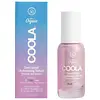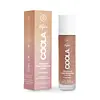What's inside
What's inside
 Key Ingredients
Key Ingredients

 Benefits
Benefits

 Concerns
Concerns

 Ingredients Side-by-side
Ingredients Side-by-side

Butyl Methoxydibenzoylmethane 3%
UV AbsorberEthylhexyl Salicylate 4%
UV AbsorberOctocrylene 8%
UV AbsorberAloe Barbadensis Leaf Juice
Skin ConditioningButyloctyl Salicylate
Skin ConditioningGlycerin
HumectantAmmonium Acryloyldimethyltaurate/Vp Copolymer
CI 77163
Cosmetic ColorantLactobacillus Ferment
Skin ConditioningJasminum Sambac Leaf Cell Extract
MaskingTheobroma Cacao Seed Extract
AntioxidantSchinus Molle Extract
Skin ProtectingWater
Skin ConditioningTitanium Dioxide
Cosmetic ColorantEthyl Ferulate
AntioxidantTropolone
Skin ConditioningMica
Cosmetic ColorantHydroxyacetophenone
AntioxidantPropanediol
SolventButylene Glycol
HumectantSodium Stearoyl Glutamate
Cleansing1,2-Hexanediol
Skin ConditioningCaprylyl Glycol
EmollientEthylhexyl Hydroxystearate
EmollientMaltodextrin
AbsorbentSodium Phytate
Parfum
MaskingButyl Methoxydibenzoylmethane 3%, Ethylhexyl Salicylate 4%, Octocrylene 8%, Aloe Barbadensis Leaf Juice, Butyloctyl Salicylate, Glycerin, Ammonium Acryloyldimethyltaurate/Vp Copolymer, CI 77163, Lactobacillus Ferment, Jasminum Sambac Leaf Cell Extract, Theobroma Cacao Seed Extract, Schinus Molle Extract, Water, Titanium Dioxide, Ethyl Ferulate, Tropolone, Mica, Hydroxyacetophenone, Propanediol, Butylene Glycol, Sodium Stearoyl Glutamate, 1,2-Hexanediol, Caprylyl Glycol, Ethylhexyl Hydroxystearate, Maltodextrin, Sodium Phytate, Parfum
Titanium Dioxide 5.6%
Cosmetic ColorantAluminum Hydroxide
EmollientCaprylhydroxamic Acid
Caprylyl Glycol
EmollientCarthamus Tinctorius Seed Oil
MaskingCitrus Aurantium Dulcis Fruit Water
MaskingCocoglycerides
EmollientCommiphora Myrrha Leaf Cell Extract
MaskingCucumis Sativus Fruit Extract
EmollientDicaprylyl Carbonate
EmollientEuterpe Oleracea Fruit Oil
Skin ConditioningAroma
Glycerin
HumectantHelianthus Annuus Seed Extract
Skin ConditioningHelianthus Annuus Seed Oil
EmollientHydrogen Dimethicone
Hydrolyzed Wheat Protein/Pvp Crosspolymer
Hydroxyethyl Acrylate/Sodium Acryloyldimethyl Taurate Copolymer
Emulsion StabilisingIron Oxides
Mica
Cosmetic ColorantOctyldodecyl Oleate
EmollientOryza Sativa Bran Oil
EmollientPlankton Extract
Skin ConditioningPropanediol
SolventRosa Alba Leaf Cell Extract
AntioxidantRosa Centifolia Leaf Cell Extract
AntioxidantRosa Damascena Leaf Cell Extract
Skin ProtectingRosmarinus Officinalis Leaf Extract
AntimicrobialSodium Citrate
BufferingTrisodium Ethylenediamine Disuccinate
Water
Skin ConditioningXanthan Gum
EmulsifyingTitanium Dioxide 5.6%, Aluminum Hydroxide, Caprylhydroxamic Acid, Caprylyl Glycol, Carthamus Tinctorius Seed Oil, Citrus Aurantium Dulcis Fruit Water, Cocoglycerides, Commiphora Myrrha Leaf Cell Extract, Cucumis Sativus Fruit Extract, Dicaprylyl Carbonate, Euterpe Oleracea Fruit Oil, Aroma, Glycerin, Helianthus Annuus Seed Extract, Helianthus Annuus Seed Oil, Hydrogen Dimethicone, Hydrolyzed Wheat Protein/Pvp Crosspolymer, Hydroxyethyl Acrylate/Sodium Acryloyldimethyl Taurate Copolymer, Iron Oxides, Mica, Octyldodecyl Oleate, Oryza Sativa Bran Oil, Plankton Extract, Propanediol, Rosa Alba Leaf Cell Extract, Rosa Centifolia Leaf Cell Extract, Rosa Damascena Leaf Cell Extract, Rosmarinus Officinalis Leaf Extract, Sodium Citrate, Trisodium Ethylenediamine Disuccinate, Water, Xanthan Gum
Alternatives
Ingredients Explained
These ingredients are found in both products.
Ingredients higher up in an ingredient list are typically present in a larger amount.
Caprylyl Glycol is a humectant and emollient, meaning it attracts and preserves moisture.
It is a common ingredient in many products, especially those designed to hydrate skin. The primary benefits are retaining moisture, skin softening, and promoting a healthy skin barrier.
Though Caprylyl Glycol is an alcohol derived from fatty acids, it is not the kind that can dry out skin.
This ingredient is also used as a preservative to extend the life of products. It has slight antimicrobial properties.
Learn more about Caprylyl GlycolGlycerin is already naturally found in your skin. It helps moisturize and protect your skin.
A study from 2016 found glycerin to be more effective as a humectant than AHAs and hyaluronic acid.
As a humectant, it helps the skin stay hydrated by pulling moisture to your skin. The low molecular weight of glycerin allows it to pull moisture into the deeper layers of your skin.
Hydrated skin improves your skin barrier; Your skin barrier helps protect against irritants and bacteria.
Glycerin has also been found to have antimicrobial and antiviral properties. Due to these properties, glycerin is often used in wound and burn treatments.
In cosmetics, glycerin is usually derived from plants such as soybean or palm. However, it can also be sourced from animals, such as tallow or animal fat.
This ingredient is organic, colorless, odorless, and non-toxic.
Glycerin is the name for this ingredient in American English. British English uses Glycerol/Glycerine.
Learn more about GlycerinMica is a naturally occurring mineral used to add shimmer and color in cosmetics. It can also help improve the texture of a product or give it an opaque, white/silver color.
Serecite is the name for very fine but ragged grains of mica.
This ingredient is often coated with metal oxides like titanium dioxide. Trace amounts of heavy metals may be found in mica, but these metals are not harmful in our personal products.
Mica has been used since prehistoric times throughout the world. Ancient Egyptian, Indian, Greek, Roman, Aztec, and Chinese civilizations have used mica.
Learn more about MicaPropanediol is an all-star ingredient. It softens, hydrates, and smooths the skin.
It’s often used to:
Propanediol is not likely to cause sensitivity and considered safe to use. It is derived from corn or petroleum with a clear color and no scent.
Learn more about PropanediolTitanium dioxide is a mineral UV filter widely used in sunscreens and cosmetics.
It is one of only two UV filters officially classified as “mineral” by regulatory agencies, the other being zinc oxide.
Titanium dioxide provides broad-spectrum protection mostly in the UVB and UVAII range, with some protection in the UVAI range.
While its UVA protection isn’t as strong as zinc oxide’s, the difference is minor.
A common myth is that mineral UV filters reflect UV light. However, modern research shows titanium dioxide absorbs UV radiation like chemical filters (~95% absorption & 5% reflection).
Thanks to its non-irritating nature, titanium dioxide is suitable for sensitive, acne-prone, or redness-prone skin. It is unlikely to cause "eye sting" like other sunscreen ingredients.
A major drawback of this ingredient is its white cast and thick texture. This is why mineral sunscreens often leave a white cast and are less cosmetically elegant than chemical/hybrid sunscreens.
To improve white cast and spreadability, micronized or nano-sized titanium dioxide is often used.
There are ongoing concerns surrounding nano-titanium oxide's impact on marine ecosystems.
There is no conclusive evidence that any form of titanium oxide (or any other sunscreen ingredients) will cause harm to marine ecosystems or coral reefs. The science is still developing but many consumers are keeping a close eye on this issue.
Please note, many destinations have reef-safety sunscreen rules. For instance, the U.S. Virgin Islands advises all visitors to use non-nano mineral sunscreens.
Nano mineral sunscreens once raised safety concerns about absorption into skin.
Extensive research has shown that they do not penetrate healthy or damaged skin; they remain safely on the surface and the top layer of dead skin (stratum corneum).
You'll likely find titanium dioxide bundled with alumina, silica, or dimethicone. These ingredients help make titanium dioxide highly photostable; this prevents it from interacting with other formula components under UV light.
Learn more about Titanium DioxideWater. It's the most common cosmetic ingredient of all. You'll usually see it at the top of ingredient lists, meaning that it makes up the largest part of the product.
So why is it so popular? Water most often acts as a solvent - this means that it helps dissolve other ingredients into the formulation.
You'll also recognize water as that liquid we all need to stay alive. If you see this, drink a glass of water. Stay hydrated!
Learn more about Water